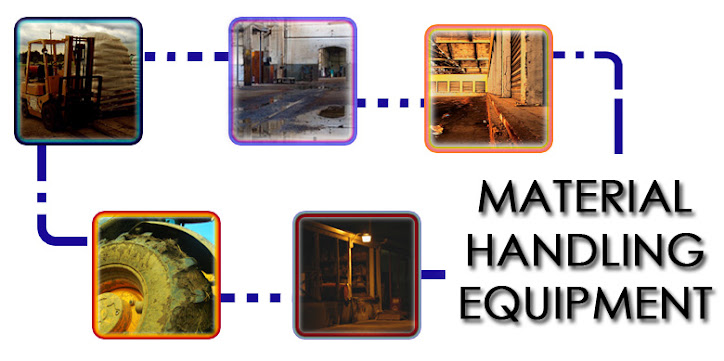Conveyors have attained a dominant position in the warehousing function, especially on transportation due to such inherent advantages as their economy and safety of operation, reliability, versatility, and practicall unlimited range of functions aside from their normal purpose of providing a continuous flow of material between operations. Furthermore, their conformity to environmental requirements has given conveyors the incentive to be the option for material handling equipments.
Here are some of the economical benefits provided by the conveyor system:
1. Variety of materials handled
The materials carried by conveyors can range from very fine, dusty chemicals to large, lumpy ore stone, coal or pulpwood logs. They are carried with minimum degradation as they are on stationary position on the belt of the conveyors.
With the use of rubber belts, conveyors are highly resistant to corrosion and abrasion. thus, maintenance costs are comparatively low when handling materials such as alumina and sinter.
2. Continuous operations
Conveyors operate continuously without loss of time for loading and unloading or empty return trips. Scheduling is easier and dispatching is almost unnecessary. They provide continuous flow of materials while avoiding confusion, delays, and safety hazards in congested aread. In addition, the costs per ton has decreased dramatically as the annual ton handled increases.
3. Adaptability to path of travel
The conveyor system provides the means of transporting materials through the shortest distance betwee the require loading and unloading points. They are weather protected and can be provided with structures which prevent the escape of dust to the surrounding atmosphere.
4. Accuracy
The movement of the goods on the conveyors can be scheduled in the most concise manner; and even more interesting is the services performed on the goods. While being transported through the conveyors, materials can also be weihed accurately and continuously or they can be sorted, picked, or sprayed. In many cases, such operations are performed on the goods when they are being transported to increase warehouse efficiency.
5. Reliability and Availability
Conveyors are operated at the touch of a button at any time of the day; shift after shift. They can also be housed so that both they and the material being transported are protected from elements that would impede the movement of trucks and certain other means of transportation.
6. Safety
Just few personnels are required to operate the conveyor system and thy are exposed to fewer hazards. Materials are contained on the belt and personnel are not endangered by falling lumps or the malfunction of huge unwieldy transport vehicles. Furthermore, conveyors offer less hazards to careless personnel than is inherent in other means of transporting bulk materials.
Not only is the employee safety improved, but the equipment itself too. Conveyors can be protected from overload and malfunction by built-in mechanical and electrical safety devices.
7. Low labor costs
The labor hours per ton required to operate the conveyor system is the fewest amongst all the methods of transporting materials. It is highly automated, incurs low operating costs, and provides higher return on investment.
Most functions of the system can be monitored from a central control panel or controlled by a computer requiring a minimum number of operating personnel to inspect the equipment and report conditions that may need maintenance.
8. Low power costs
Because conveyors are operated by electric power, they are less affected by the pries, shortages, and other limitations of liquid fuel. They consume power only when they are used and there is no need for empty return trips or idling in line for the next load.
9. Low maintenance costs
Maintaining conveyors can be extremely low, as surprising as it may sound. Extensive support systems associated with truck haulage are not required. Component parts are usually housed and have very long life compared with that of motor vehicles.
Usually, they only need scheduled inspections and lubrications an any repais or replacements can be anticipated. Thus, unscheduled downtime is avoided.
Parts are small ad accessible so replacements can be made on the site quickly and with minimal service equipment. In addition, adequate inventories of spare parts can be maintained at a alow cost and also require very little storage space.
10. Environmental advantages
The conveyor system is environmentally more acceptable than other means of transporting materials as they do not pollute the air nor deafen the ears. They operate quietly and do not contaminate the air with dust or hydrocarbons.
taken from: Belt Conveyors for Bulk Materials, Third Edition
-ann-


5 comments:
We always look forward to putting our experience to work for your company with wide variety of applications including almonds, bacon bits, plastics and recycled waste.
Conveyors and Equipment
This is an amazing blog , it provides so much information
click here
Nice Blog
Neo conveyors India’s Leading material handling equipments manufacturing ISO 9001:2000 certified company – Conveyors India, Conveyors,Conveyors manufacturer, Conveyor supplier, Conveyors systems,Conveyor automation, Conveyor belt system, Conveyor chain, Conveyor fabricator, Conveyor handing systems, Conveyors manufacturers in India,Manufacturers of conveyors in India.
Belt Conveyors
Trough Belt Conveyors
Truck Loading Conveyors
Radial Stacker
Chain Conveyors
Drag Chain conveyors
Screw Conveyors
Mixer Blender
Bucket Elevators
conveyor belting Distributor
Awesome, Good to find this informative blog.
Material Handling Systems
Post a Comment